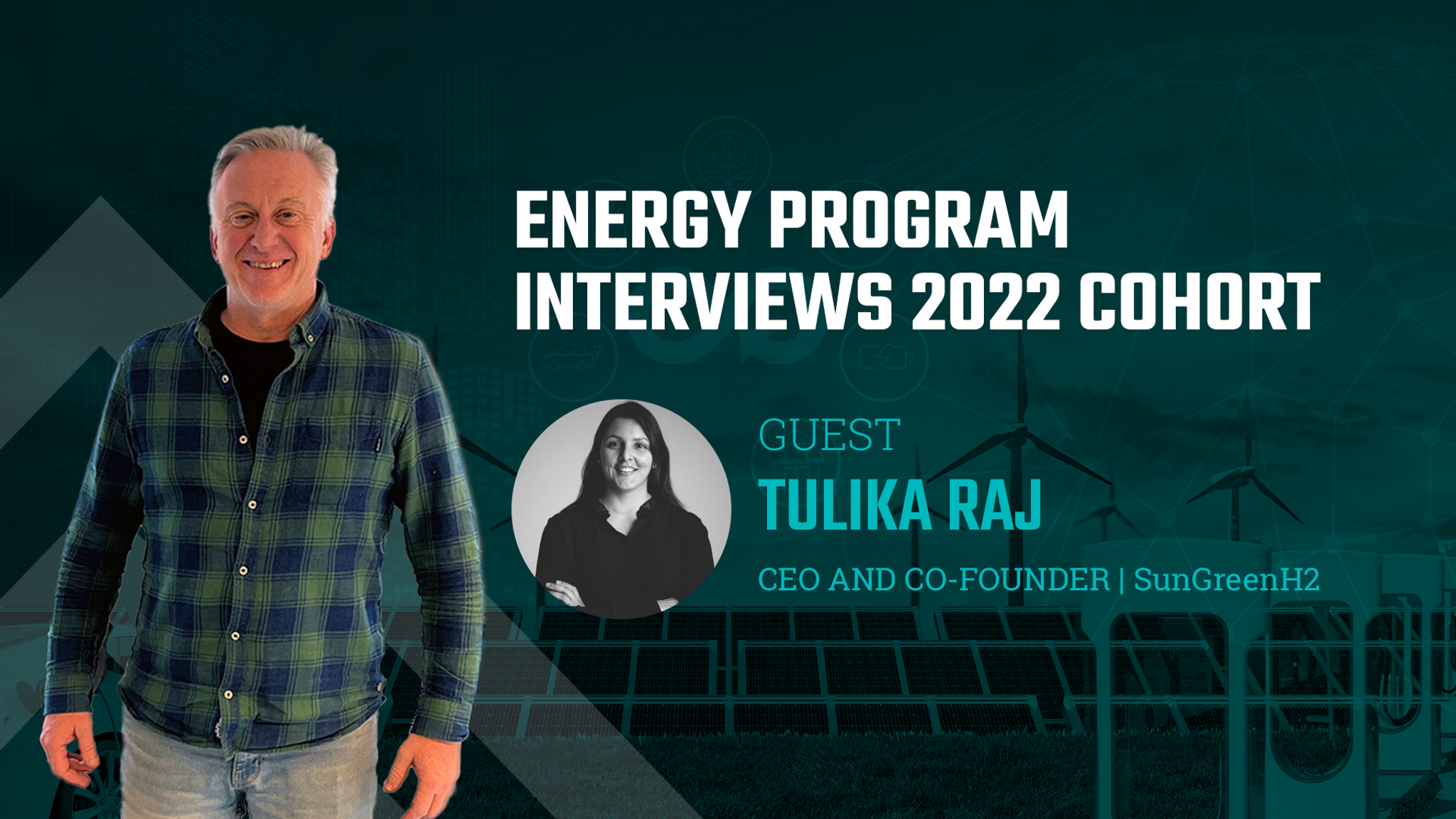Raising Capital from Energy and CleanTech Investors- Tulika Raj from SunGreenH2
Stuart Allinson
Published on

Stuart, Energy Partner at Startupbootcamp, recently interviewed Tulika Raj, Co-founder and CEO of SunGreenH2.
Tulika is a serial entrepreneur in the energy space. She met her co-founder Saeid Masudy Panah at an incubator in SIngapore in the midst of the pandemic in 2020 and both connected over a shared vision for green hydrogen as a tool for wide-scale decarbonization. From there, they formed SunGreenH2. Their complementary skill set and shared missions enabled them to start building a novel solution for all types of electrolyzers to dramatically bring down the cost of green hydrogen.
The team has expanded rapidly over the last 2 years and is raising capital to scale. Tulika shares her insights and tips around engaging investors as she’s right in the midst of this growth stage.
Here are some of the learnings she shared in the interview. You can watch the interview or read about the key learnings below.
Raise what you need...but also think carefully about dilution
At the start of a startup’s journey, you generally receive small dollars from friends and family and incubators which is great to build a prototype and get the necessary patents. But then you need to raise new funds to grow and achieve your vision.
In this growth stage as you’re trying to raise those larger sums of money, Tulika mentions, they have been very careful during capital raising to balance dilution vs raising what they need for the business to achieve its goals.
This means taking a step back and being clear about the plan (even though it might still change) and the necessary resources to hit those milestones in the plan. Once you have that, it’s all about finding the right investors.
Tulika compares building a business to delivering a large project on time and on budget, and the investors are your “managers”. Like with all projects, it’s about managing expectations right from the outset.
It’s important to have a vision for where you’re going but also be realistic around the assumptions you’ve made in the plan. Then keeping those communication lines open around why things are changing and how they are changing is super important to ensure no one is surprised if the plan doesn't work out as originally envisioned or certain goals change along the way.
Having the right investors
Another important part of the capital raising process is having the right investors behind you who are completely aligned with you, understand the different elements of your journey and can help the business grow.
Tulika mentioned they welcome working with institutional investors that have deep insight in their space and are invested in the energy transition. One of their top priorities is having investors that can envision what the energy landscape will look like in the future and also understand that electrolysis based green hydrogen and the hydrogen space in general is broadly about enabling both energy security and decarbonization at the same time.
Communicating with investors
With these investors, Tulika also dives deep into her method of communicating with the different stakeholders to ensure they’re working together as a team to bring the bigger vision to life.
Firstly, the SunGreenH2 team has regular board meetings. They also update their stakeholders either quarterly or monthly depending on volume of updates, making sure to highlight both - what’s going well and the challenges of their journey. Keeping the KPIs front and centre and clearly articulating them to the investors is critical to keep everything clear and everyone focused.
Starting a business will never go according to plan and with every win there are some times you lose too. Trying to understand what went wrong and why is crucial to forging ahead. Then communicating that to investors keeps everyone informed and helps manage expectations down the line.
Juggling building the business and fundraising
Shifting gears to the actual process of capital raising, Tulika shares some thoughts around being strategic and organised when fundraising. The whole process is time-consuming and can really distract founders when their main priority is to build the business.
So Tulika and the team try to be organised and strategic about when they think they’ll need to be raising. When you’re ready to raise, take the time to prepare and fill out that data room and document what your company is about - so you’re not repeating the same information in multiple investors meetings, but it’s available in documented form already.
Even though they’re always open to talking to investors and the CEO wears multiple hats in a company, they have to be disciplined about allocating time to raising capital versus focusing on what matters most - building the business. So by planning when their next round will open, they can keep those lines of communication open between investors and ensure they continue to engage with them until the opportune moment arises.
The diversity of opinion on the cap table? Helpful or harmful?
Tulika shares how, ultimately, shareholders are partners. They must be aligned around the vision of the company and what they’re trying to deliver. Ultimately, they’re all a team working together to try and deliver a 100x kind of result.
When inviting investors to join the cap table, it’s important to understand how well they are aligned and how they can help strategically. A startup or scaleup might receive a great term sheet but there might not be that “meeting of minds”. And that’s when you have to make those gut decisions.
On the other hand, if the startup and the investors have a shared vision, are committed to making it happen and there is also that cultural fit and understanding, it’s going to be a great partnership.
What’s in the immediate future for SunGreenH2?
After 2 years of growing exponentially, SunGreenH2 are pushing the limits of green hydrogen production efficiency and cost. Their aim is to dramatically improve the efficiency of producing green hydrogen from all electrolysers, eliminate critical resource constraints like use of precious metals and drive down the cost of green hydrogen making it affordable so there is an incentive for wide-scale adoption of green hydrogen as opposed to grey hydrogen to drive industrial decarbonization.
We can’t wait to see how they grow!
If you found this helpful. Make sure to sign up to our newsletter to get more startup content straight to your inbox 👉 https://share.hsforms.com/1nqWdL9kkTGCAqIUYRoXpRg5b7xu
